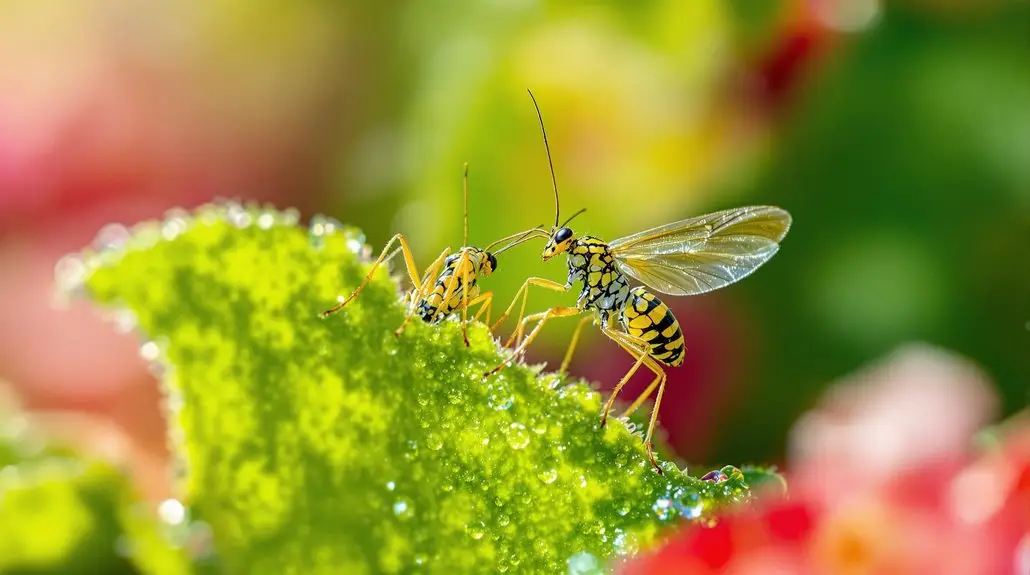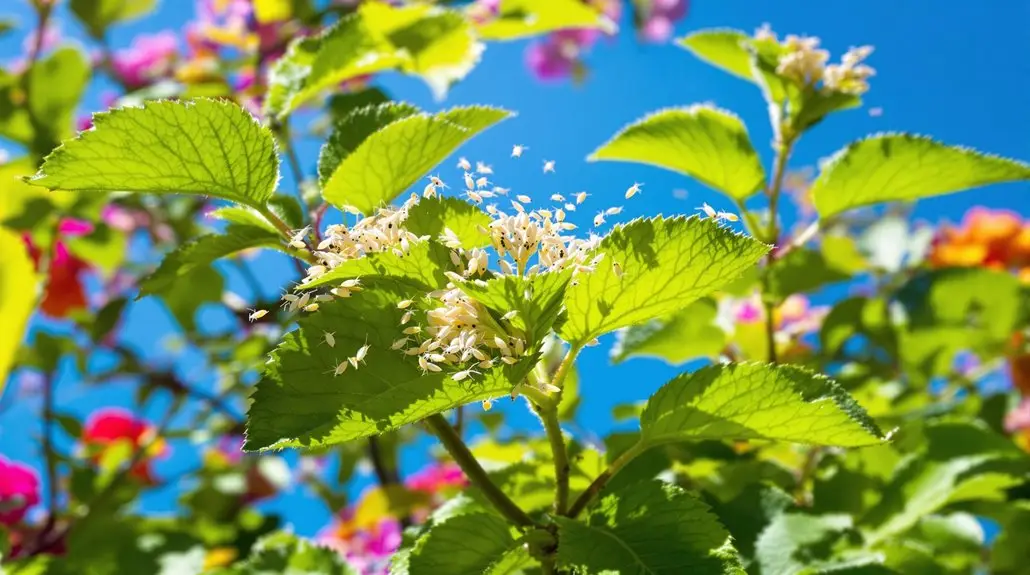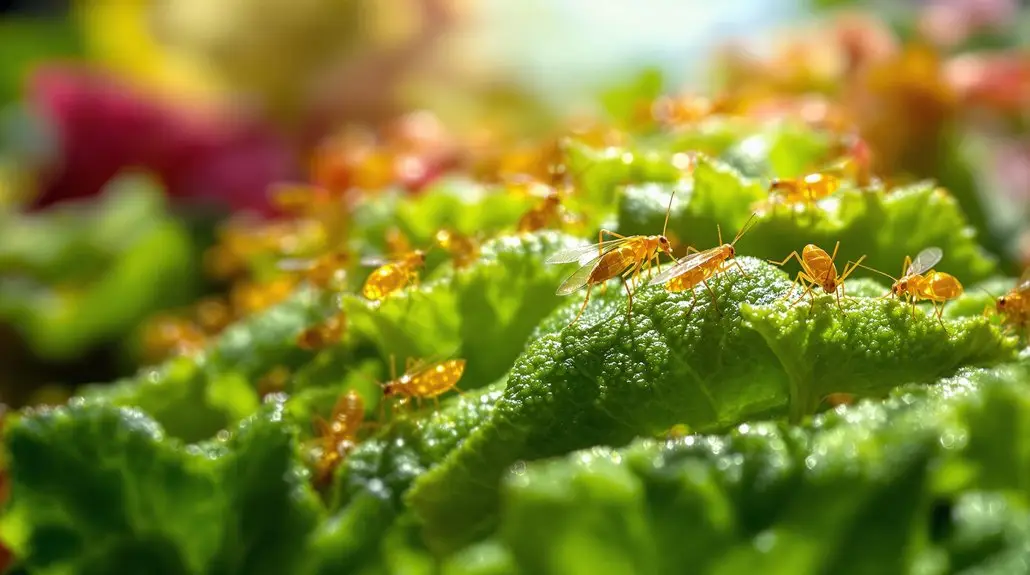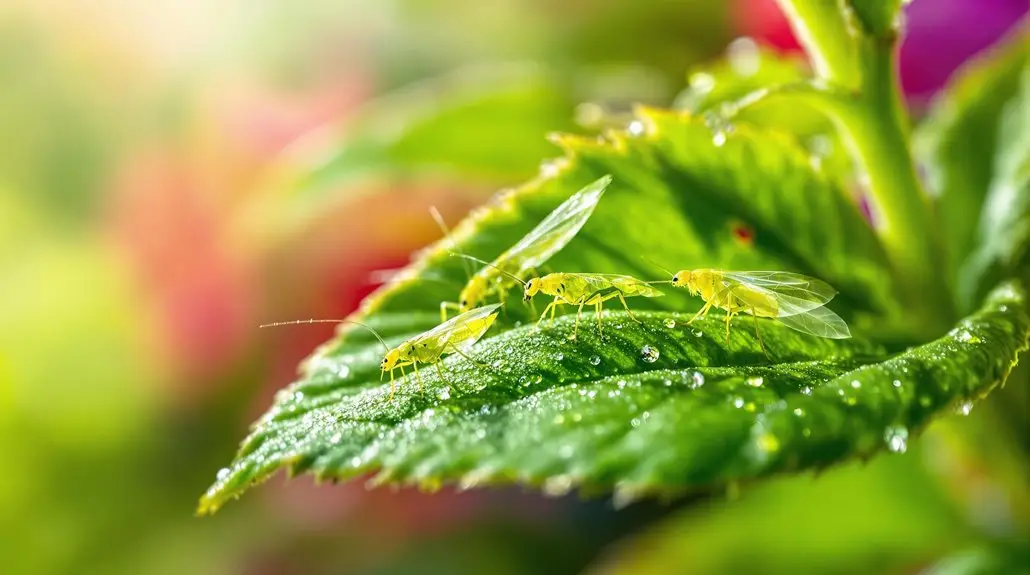Scirtothrips dorsalis, known as the chili thrip, exhibits distinct dispersal patterns influenced by environmental factors like temperature and humidity. In South Florida, these factors dictate the timing of their movement among ornamental host plants, primarily during warmer months when populations peak. Researchers have identified that wind currents facilitate long-distance travel, while local dispersal guarantees thrips colonize nearby vegetation effectively. Understanding these dynamics is crucial for developing targeted pest management strategies, and you'll discover further insights into their control methods.
Key Insights
- Scirtothrips dorsalis dispersal is influenced by wind currents, affecting its movement between ornamental host plants in South Florida.
- Temperature and humidity significantly impact the timing and intensity of thrips' diurnal flight activities on select host plants.
- Populations of chili thrips peak in late spring, summer, and fall, aligning with the availability of preferred ornamental plants.
- Local dispersal is crucial for colonization, with adults primarily found near preferred host plants, such as roses and strawberries.
- Monitoring with sticky traps assists in understanding dispersal patterns and timing, aiding effective pest management strategies.
Overview of Scirtothrips Dorsalis

The tiny yet impactful *Scirtothrips dorsalis*, commonly known as the chili thrip, poses considerable challenges to ornamental plants in South Florida due to its rapid life cycle and extensive host range. This pest completes its entire life cycle in just 14 to 20 days under ideal conditions, consisting of an egg stage, two larval stages, and two "false" pupal stages before maturing into adults. Females, capable of parthenogenesis, can lay between 60 to 200 eggs, markedly influencing population dynamics. With over 100 recorded host plants from about 40 families, *S. dorsalis* primarily targets young leaves, buds, and fruits, causing cell damage that results in distortion, defoliation, and indirect damage through virus transmission, thereby exacerbating crop loss. Additionally, its ability to vector plant-pathogenic viruses further complicates management efforts and increases economic threats to agriculture.
Environmental Factors Influencing Dispersal

While various environmental factors profoundly influence the dispersal of *Scirtothrips dorsalis*, temperature emerges as a critical determinant, affecting both the life cycle and population dynamics of this pest. Warmer temperatures accelerate its lifecycle, allowing multiple generations to thrive each year. Additionally, humidity plays a role, impacting thrips activity and survival by affecting plant moisture, which is essential for feeding. Solar radiation influences their diurnal flight patterns, as they are most active during daylight. Wind currents considerably aid long-distance dispersal, transporting thrips over vast distances. Finally, the diversity of available host plants, including ornamental species, provides alternative feeding sites that further enhance the dispersal capabilities of *S. dorsalis*, allowing it to exploit various environments effectively. Furthermore, the presence of eco-friendly pest control methods can help mitigate the impact of these pests on ornamental plants in the region.
Seasonal Population Dynamics

Understanding the seasonal population dynamics of *Scirtothrips dorsalis* reveals critical insights into its lifecycle and behavior, particularly as these dynamics fluctuate with environmental conditions and host plant availability. You'll notice that populations peak late in spring, summer, and fall, while low populations occur during late winter and early spring. These peaks often align with the availability of preferred host plants, such as roses and strawberries, which greatly influence the thrips' density on ornamental plants. Additionally, the presence of natural enemies increases during peak seasons, which can impact plant damage more severely. High temperatures also accelerate the reproductive cycle, enabling rapid population growth and adaptation to new environments, making effective monitoring and management strategies essential for controlling this pest. Furthermore, seasonal dispersal patterns suggest that dispersal timing is critical for effective pest management. Implementing effective mosquito control methods can also help reduce the overall pest population in shared environments.
Dispersal Patterns and Mechanisms
When examining the dispersal patterns of *Scirtothrips dorsalis*, it's essential to take into account the influence of environmental factors such as wind, temperature, and humidity. You'll find that wind aids in long-distance movement, while temperature and humidity greatly affect the timing and intensity of these insects' diurnal flight activities. By understanding these mechanisms, you can better appreciate how these thrips navigate their surroundings and utilize host plants for feeding and reproduction. Additionally, this species is known to affect over 112 plant species across various families, which influences its dispersal behavior and host plant selection. Effective pest control measures are crucial in high-risk areas where these pests thrive.
Wind Influence on Dispersal
Wind plays a significant role in shaping the dispersal patterns of *Scirtothrips dorsalis*, as the direction of the wind directly influences where these thrips are likely to travel. Research shows that fewer adults are caught in traps positioned north, east, or south of host plants compared to those located west, which aligns with prevailing wind patterns. Wind facilitates long-distance travel and colonization of new areas, particularly in Florida, where *S. dorsalis* has become widespread. Understanding these dispersal patterns is vital for developing effective control strategies, as local dispersal is essential for successful colonization. Additionally, wind assists in moving thrips between different host plants, thereby enhancing their spread across various ornamental species and contributing to population dynamics.
Temperature and Humidity Effects
Temperature and humidity greatly influence the dispersal patterns and mechanisms of *Scirtothrips dorsalis*, as these climatic factors directly affect the thrips' density and distribution across various ornamental plants.
- Higher temperatures promote increased thrips populations, with ideal activity occurring above 24°C. Additionally, the mean incubation time for eggs is approximately 7-10 days, which can be influenced by temperature and moisture conditions.
- Low humidity levels correlate negatively with thrips dispersal, impacting their settlement on plants.
- Rainfall patterns also play a role; areas with low precipitation favor thrips development, while excessive rainfall can hinder their survival.
- Seasonal fluctuations in climate cause population peaks from late spring to fall, indicating their adaptability to changing environmental conditions.
Understanding these relationships helps in predicting and managing the spread of *S. dorsalis* on ornamental plants in South Florida.
Diurnal Activity Patterns
The diurnal activity patterns of *Scirtothrips dorsalis* reveal significant insights into their dispersal mechanisms and behaviors, particularly as these patterns are closely linked to environmental conditions and host plant preferences. You'll notice that these thrips are primarily active during the day, with peak flight activity occurring between 9:00 a.m. and 2:00 p.m. EST. Increased light intensity correlates with heightened dispersal, making their local movements essential for successful colonization, especially on preferred hosts like roses. Dispersal diminishes with distance from the host plant source, indicating a strong preference for areas closer to their food. Monitoring efforts, including yellow sticky traps, can effectively capture their activity patterns, helping you understand their behaviors and optimize management strategies accordingly.
Control Measures and Management Strategies
To effectively manage Scirtothrips dorsalis, you should consider integrating biological control agents alongside other management strategies. Utilizing predators such as minute pirate bugs and phytoseiid mites can greatly reduce thrips populations while minimizing chemical pesticide use. By adopting an integrated approach that combines these biological methods with cultural and chemical practices, you'll enhance the overall effectiveness of your pest management efforts. NaturePest offers eco-friendly treatment options that align with these strategies. Early detection through field scouting is crucial for implementing these strategies effectively.
Biological Control Agents
- Predatory Mites: *Amblyseius swirskii* effectively suppresses *S. dorsalis* larvae for up to 21 days post-treatment. This biocontrol agent has shown comparable efficacy to conventional insecticides, emphasizing its role in integrated pest management(A. swirskii).
- Entomopathogenic Fungi: *Purpureocillium lilacinum* shows effectiveness comparable to chemical insecticides in field trials.
- Minute Pirate Bugs: *Orius* spp. target both adult and larval thrips stages, providing extensive control.
- Entomopathogenic Nematodes: *Thripinema* spp. parasitize adult thrips females, preventing egg-laying.
Employing these agents not only enhances pest management but also promotes environmental security and sustainability in agriculture.
Integrated Management Approaches
Integrated Management Approaches (IMAs) encompass a range of strategies designed to effectively manage *Scirtothrips dorsalis* populations on ornamental plants, ensuring both pest control and environmental sustainability. You can start by employing monitoring techniques, such as yellow and blue sticky traps and plant sampling methods, to detect thrips early, particularly during peak seasons. Implement cultural control methods, like crop rotation and sanitation practices, to disrupt their lifecycle. Additionally, while chemical control can be essential, rotating insecticides helps prevent resistance. The life cycle of *Scirtothrips dorsalis* can occur in as little as 15 days under optimal conditions, emphasizing the importance of timely interventions. Integrating these practices within an Integrated Pest Management (IPM) framework allows you to make informed decisions based on economic thresholds and ongoing evaluations. Finally, consider technological innovations for precision applications, enhancing overall effectiveness in managing thrips populations.
Economic Impact on Ornamental Plants
As the ornamental plant industry continues to grapple with the challenges posed by Scirtothrips dorsalis, understanding the economic impact of this pest becomes crucial for growers and retailers alike. This pest infests various ornamental plants, leading to significant crop damage and economic losses. The consequences include:
- Reduced Aesthetics: Infestation causes upward curling and bronzing of leaves, diminishing plant appeal. Moreover, these pests are known for their rapid life cycle, allowing for multiple generations within a single year, which can exacerbate damage.
- Premature Flower Drop: Damage to blooms can result in lower quality and quantity of flowers.
- Increased Production Costs: Intensive pest control measures raise operational expenses.
- Lower Sales: Reduced ornamental value may lead to decreased revenue for nurseries and garden centers.
Monitoring Techniques and Best Practices
To effectively manage Scirtothrips dorsalis, employing a variety of monitoring techniques is essential, as accurate detection is crucial for timely intervention and pest management. Utilize blue or yellow sticky traps for early detection of thrips infestations, and consider integrating multispectral satellite imagery to analyze plant health changes. Implement field scouting programs that focus on specific plant parts, enhancing data gathered from satellite imagery. Leverage smartphone apps with deep-learning capabilities for real-time thrips classification, improving detection efficiency. For spatial analysis, employ grid sampling in fields, using ten young shoots per unit to estimate thrips density. Regular monitoring will track changes over time, identifying peak infestation periods and informing effective management strategies. Additionally, incorporating eco-friendly products in pest management can further mitigate environmental impact while controlling thrips populations.
Final Thoughts
The Intricate Dance of Dispersal: Safeguarding South Florida's Gardens
Ultimately, understanding the dispersal dynamics of *Scirtothrips dorsalis* reveals the intricate web connecting environmental factors, seasonal changes, and ornamental plant health. As researchers have meticulously traced its movements, they highlight the urgent need for effective management strategies to mitigate economic impacts.
To ensure that vibrant gardens in South Florida continue to flourish, unaffected by the encroaching shadow of this invasive pest, we encourage you to take action. Partner with NaturePest Holistic Pest Control for tailored monitoring techniques and sustainable pest management solutions. Together, we can protect our precious ornamental plants and maintain the beauty of South Florida's landscapes.



